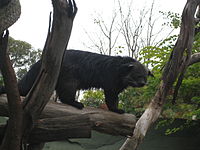Binturong

Template:Taxobox begin Template:Taxobox begin placement Template:Taxobox regnum entry Template:Taxobox phylum entry Template:Taxobox classis entry Template:Taxobox ordo entry Template:Taxobox familia entry Template:Taxobox genus entry Template:Taxobox species entry Template:Taxobox end placement Template:Taxobox section binomial parens Template:Taxobox end
The Arctictis binturong, also known as the Malay civet cat, the binturong, the Asian bearcat, and the Palawan bearcat, is neither a bear nor a cat but is a type of civet of the family Viverridae. The binturong is endangered due to habitat destruction and poaching for their medicinal uses and their fur. Its natural habitat is forest canopy, and it spends most of its time in the trees of southeast Asia, Borneo, Vietnam, Malaysia, Indonesia and Palawan Island.
They are nocturnal and sleep on branches. Their bushy tails are fully prehensile and act as a fifth hand. They are about the size of a large house cat, averaging about 60–95 cm (24–37 in) and 9-14 kg (20–31 lb). The tail is nearly as long as the body with size ranging from 55–90 cm. The ears are small and rounded and it has small eyes. They eat primarily fruit, but also have been known to dine on eggs, shoots and leaves, and small animals including rodents and birds. Deforestation has greatly reduced their numbers. When cornered, a bearcat can be vicious. But a binturong can also make chuckling sounds when it seems to be happy. Binturongs can live over 20 years in captivity. One is recorded to have lived almost 26 years.

- Estrus period: 81 Days
- Gestation: 91 Days
- Offspring: Usually 2 (up to 6)
Binturongs climb trees and leap from leaf to leaf, using their tails and claws to cling while searching for fruit, eggs, leaves, birds, and rats. Binturongs also use their tails to communicate, through the scent gland located under said tail (the scent of binturong musk is often compared to that of warm popcorn). Binturongs brush their tails against trees and howl to announce their presence to fellow binturongs. Slow and graceful, the binturong hunts in the night and sleeps during the day.
External links
- Carnivore Preservation Society entry on binturong
- web page with image
- http://www.pcsd.ph/photo_gallery/fauna/bearcat.htm
- Photo in a tree
- Deleware Public School report including one photo and several links
- The Binturong Information Sheet by Mindy Stinner - based on observations of animals at the Carnivore Preservation Trust (CPT) in Pittsboro, NC
